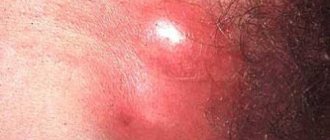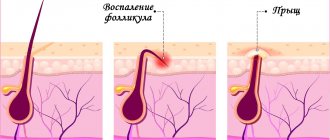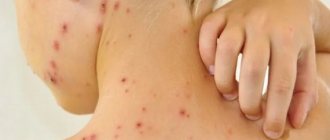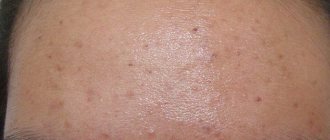After shaving or waxing, many of us face such a problem as ingrown hairs. Not only women, but also men are susceptible to this problem. You are faced with the question: “how to get rid of an ingrown hair?”, because this is not only a cosmetic defect. Ingrown hair causes pain, inflammation and a local increase in temperature. Let's look at what methods you can use to remove ingrown hair, and what measures will help prevent its occurrence.
What do ingrown hairs look like?
Ingrown hairs are not a dangerous skin disease, but they can cause a lot of inconvenience and discomfort to a person. An ingrown hair is a small, brown or reddish formation on the skin in the form of a tubercle with serous or purulent contents, in which the growing hair may or may not be visible.
Ingrown hairs occur because after shaving, laser hair removal or depilation, hair grows deeper into the skin rather than outward, causing inflammation and irritation. This happens because dead skin clogs the hair follicle, causing hair to grow under the skin rather than up and out.
Types of ingrown hairs
What causes hair growth?
The content of the article
This happens more often to some than to others. People with thick, curly hair are more likely to have problems with ingrown hairs than people with thin, sparse hair. This is especially true for pubic hair, which is usually coarser than on other parts of the body.
The most common cause of ingrown hairs is hair removal. The more often you remove them, the more they grow. Most will grow normally, but some will continue to develop under the skin. Shaving and waxing can cause frizz, which can grow back into the skin.
When hair continues to grow on the skin, the body perceives it as a foreign body. Symptoms then appear, including pain, itching, redness or swelling.
Symptoms of ingrown hairs
In men, ingrown hairs most often appear after shaving in the beard area, on the neck, cheeks and chin. They can also appear on the surface of the head if a man shaves it. Ingrown hairs in women most often occur on the legs, bikini line and pubic area, armpits and around the buttocks. Signs indicating unwanted hair include the following:
- Hard bumps, small in size and round in shape (so-called papules);
- Small pustules that are filled with pus or serous contents;
- Itching, hyperpigmentation of the skin, pain.
Complications
Adverse consequences may occur if pseudofolliculitis is removed incorrectly on your own or if ingrown hairs occur frequently.
Possible complications:
- Penetration of pathogenic bacteria into an ingrown hair cyst with the formation of an abscess. The abscess may gradually increase in size. The infection spreads with the formation of an extensive inflammatory process.
- Scarring of the skin in the area of ingrown hairs. When an abscess opens on its own or there is extensive inflammation, a focus of connective tissue growth (scar) forms in the wound. Scarring of the skin is a cosmetic problem.
- Changes in skin color among ingrown hairs and the occurrence of recurrent pseudofolliculitis.
Professional treatment of the disease reduces the risk of complications.
Causes of ingrown hairs
Ingrown hairs most often occur after hair removal in your own bathroom, but it happens that such an unpleasant phenomenon occurs after visiting beauty salons. In order to understand how to get rid of such a problem, you need to carefully understand what exactly provokes it. Cosmetologists say that the process associated with ingrowth directly depends on the number and density of epidermal layers. If the surface contains a significant number of cells of the stratum corneum, then they make the skin too rough, so it is difficult for thin growing hair to break through. For this reason, the hair begins to follow the path of less resistance, beginning to bend and grow horizontally, and not vertically, as is usually the case.
When considering skin and hair type, people with dark, coarse hair and dark skin are most susceptible to developing this problem. The reason is that this type of hair grows much faster than blonde hair. Add thick skin to everything else, and ingrowths can no longer be avoided.
Therefore, the reasons causing this unpleasant phenomenon include the following:
- thick layer of epidermis (hyperkeratosis);
- genetic predisposition;
- disrupted hormonal levels (for example, surges of estrogen observed at the beginning of the menstrual cycle). Changes of this kind can occur with high estrogen production, as well as with a disorder of the endocrine system;
- causing damage to the hair canal during the hair removal procedure;
- the formation of a small scar in the hair canal after hair removal;
- hair curling lower than the level of the epidermis. This happens if mistakes were made during the hair removal procedure;
- shaving against hair growth (especially when the blade is not new);
- constant wearing of uncomfortable underwear made of synthetic material. Such underwear does not allow moisture to evaporate from the surface of the skin and often leads to the development of bacterial infections. It is because of this that after hair removal it is not recommended to immediately put on synthetic underwear.
It is imperative to get rid of ingrown hairs, but before carrying out such a procedure, you must understand what not to do.
Causes
The most common cause of ingrown hairs is self-depilation using a razor, wax or other product. In this case, only the outer shaft is removed while preserving the active hair follicle. With each depilation, the epidermis becomes more rigid, and the thickness of the hair shaft decreases. At a certain point, the hair can no longer break through the thickness of the epidermis, resulting in ingrowth of the hair shaft. Such a rod can grow in the direction of fatty tissue or remain in the follicle area, provoking an inflammatory process.
Causes:
- Incorrect hair removal technique. Doctors recommend entrusting depilation to professional cosmetologists. Using wax or other hair removal products at home increases the risk of developing pseudofolliculitis. Pseudofolliculitis can also appear when using an insufficiently sharp razor. In this case, depilation is accompanied by skin irritation, tissue swelling and the appearance of ulcers.
- Curly hair. After removing the superficial part of such hair, the shaft begins to curl under the skin and grow in the opposite direction.
- Rigid rods. The problem area is rarely represented by vellus hair. Most often these are the legs, neck and pubis.
- Improper skin care after depilation. Cosmetologists recommend using lotion or a special cream after sugaring. Softening and moisturizing the skin reduces the risk of inflammation.
- Frequent shaving in one place. Thus, depilation even with the appearance of small stubble increases the risk of developing pathology.
The inflammatory process after ingrown hair occurs due to the activity of the immune system. The body's defense system identifies the rod as a foreign structure, resulting in the release of inflammatory mediators. Pathogenic and opportunistic bacteria present in the skin can cause an infectious process in the area of the inflamed follicle.
What not to do when removing ingrown hair
Most people try to cope with the problem with the help of improvised objects, but such actions often lead to complications. Therefore, below is a list of actions that should be avoided:
- Use tweezers or an overly sharp needle without preliminary treatment - such manipulations can lead to infection and further inflammation;
- Do not press on the hair follicle in the place where the hair grows, because this can lead to an outpouring of serous or purulent contents deep into the skin.
How to prevent bumps from forming
Pseudofolliculitis, despite the prefix “pseudo,” is an undesirable condition for the body. The skin with such a problem looks inflamed and suppurated. Some people ignore the symptoms of pseudofolliculitis and do not treat it in any way. And in vain, because in most cases, bulges can not only be removed, but also their formation can be prevented.
How to prevent the formation of bumps due to ingrown hairs:
- Exfoliate regularly and do not forget about it before epilation. The result of the procedure is the elimination of dead cells.
- Use razors with clean, sharp blades. People who often face the problem of ingrown hairs should shave no more than 2 times in 7 days to prevent bumps.
- Wipe the skin thoroughly with an antiseptic before and after hair removal. Disinfection protects follicles from infection by microbes and inflammation.
- Wear soft cotton underwear that does not damage the delicate bikini area.
- Wax and sugar hair removal should only be done in a salon by an experienced professional. Avoid repeating the procedure soon if ingrown hairs appear.
To ensure that bumps never form in the bikini area, it is necessary to remove hair there as little as possible. As they grow, they become stronger and more susceptible to depilation.
Methods for removing ingrown hairs
What to do if hairs begin to grow in after depilation? They must be carefully removed so as not to cause additional inflammation. You can get rid of ingrown hair using the following methods:
- If they are not too deep and there is no inflammation, simply steam the skin and perform a home chemical peeling or scrubbing. You can also use a hard washcloth or a special mitten to remove dead cells of the stratum corneum. Dead cells can be removed every other day, and the skin after such procedures should be treated with a moisturizer or lotion.
- If there is inflammation, but there is no purulent vesicle or the hair is deeply embedded, mechanical hair removal is performed. This method is described in detail below. Mechanically ingrown hair can be removed at home, but it is better to leave this procedure to a specialist to avoid complications.
- A surgical method for removing an ingrown hair is carried out when a pustule with serous or purulent contents forms and there is extensive inflammation. This procedure can be performed by a surgeon in a regular clinic. The surgical method of removing ingrown hair involves opening the abscess, sanitation of the wound and removing the hair. The wound is treated with an antiseptic and a bandage or bactericidal adhesive plaster is applied.
- Photoepilation is carried out only in a cosmetology office. Ingrown hairs are destroyed by a light pulse. Not suitable for very light and gray hair.
- Electrolysis is also carried out only by a cosmetologist. Ingrown hair is removed even at great depths using a needle-electrode through which an electric current is passed.
- Laser hair removal. The most widely used and effective technique today, it can be used on skin of any color.
- Hardware procedures are carried out only in the absence of inflammation and suppuration.
- Also, to solve these problems, you can adopt traditional methods for removing ingrown hairs; they will help draw the hair shaft to the surface of the skin. To help the hair break through the skin, you need to prepare a compress of several aspirin tablets, one spoon of glycerin and water. This lotion treats the problem area. As a result, the hair itself will begin to grow outward, and it will need to be removed with tweezers, after which do not forget to disinfect the skin with an antiseptic. Another lotion option: make a paste of bodyaga powder and hydrogen peroxide and apply to the ingrown hair for 10-15 minutes, then rinse. If the burning is severe, wash off sooner.
Mechanical removal of ingrown hair at home
Step-by-step instructions will help you remove ingrown hair at home. For this manipulation, you need to stock up on a thin sterile needle (if the hair has grown deeply) and manicure tweezers. Before starting the procedure, medical tweezers must be treated with medical alcohol or an antiseptic (chlorhexidine).
- 1 step. We steam the skin in the shower to expand the pores as much as possible. Using a scrub, we get rid of the dead layer of skin.
Step 2. The area of the ingrown hair is also treated with alcohol or an antiseptic.
Step 3. You need to find the tip of the hair and carefully pick it up with a needle, slowly pulling it out, clamp the protruding hair with tweezers and pull it out by the roots. At this stage, it is extremely important not to break off the hair and remove it entirely, otherwise it will grow back.
Step 4 Lubricate the skin with an antiseptic or, better yet, an alcohol tincture of calendula, which has an anti-inflammatory effect.
This method is suitable only in situations where ingrown hairs are clearly visible.
Skin and hair
Human skin is an independent organ that performs protective, metabolic, receptor and auxiliary functions. Thanks to the skin, the body gets rid of excess fluid, regulates tissue temperature, prevents the penetration of pathogenic microorganisms into organs and protects itself from other negative external influences. In different parts of the body, the skin has a different structure, but the essential parts of the organ are the epidermis, dermis and subcutaneous fat.
The epidermis is the outermost layer of the skin. The upper part of the epidermis is formed by keratinized cells that perform a barrier function. The formation of a specific pigment (melanin) in cells contributes to skin coloring. Below the epidermis is the dermis, which contains blood vessels, follicles, nerves, muscle fibers and glands. Sweat and sebaceous glands secrete their contents onto the surface of the skin. The lowest part of the organ is subcutaneous fat, which protects the underlying tissues from temperature changes and mechanical stress.
Hair is a derivative of the human skin. The center of growth of this structure is the hair bulb (follicle), located in the dermis. The constant division of cells in this zone contributes to the gradual growth of the rod in the outer direction. The cyclicity of hair growth is associated with the activity of follicle cells. In some areas of the skin there may be inactive bulbs.
Ingrown hairs in the bikini area
Sometimes a fine ingrown hair in the groin cannot be seen through the skin. In this situation, we soften the epidermis so that the hair is closer to the surface. To do this, apply a steaming compress to the skin or take a bath. Please note that such manipulations can be performed in the absence of inflammation. As soon as the hair becomes noticeable, we perform mechanical removal of the ingrown hair. All instruments you will use must be sterile. If after steaming the hair still does not become visible, then do not try to get rid of it. In this situation, it is best to seek qualified help from a cosmetologist. At the same time, a specialist will help you figure out what exactly caused the compaction to appear.
Diagnosis and treatment
A specialist may prescribe the following diagnostic tests to establish a diagnosis:
- general blood and urine analysis;
- hormonal study;
- autoimmune research;
- scraping (if skin pathologies are suspected);
- tests for STDs;
- Ultrasound of the groin area;
- MRI;
- puncture (if cancer is suspected).
Treatment tactics depend on the diagnosis:
- pathologies resulting from blockage of the sebaceous glands are treated with ointments and creams for external use; in advanced cases, the tumor is excised by a surgeon;
- cystic formations in most cases are removed surgically;
- viral pathologies are treated with antibiotics, antiviral and immunostimulating agents;
- STDs are eliminated with antibiotics, antifungals and anti-inflammatory drugs.
Ingrown hairs in armpits
This is perhaps the most unpleasant option. Firstly, the skin in these places is extremely thin and is constantly irritated. Secondly, removing unwanted hair on your own will bring a lot of discomfort. Finally, due to the use of deodorants and increased sweating, pain is often felt in the area where such a hair is located and inflammation occurs due to infection. Therefore, the operation must be carried out extremely carefully:
- A few days before removal, we begin preparations - we treat the skin with an anti-acne preparation, which contains salicylic acid. Such lotions are too aggressive for the face, but in the area of hair growth they lead to thinning of the skin and stop the inflammatory process;
- Just before removal, remove the remaining salicylic ointment, steam the skin, and treat all instruments;
- If all the previous steps are completed correctly, then even with the naked eye it will be possible to see the ingrown hair. We carry out the hair removal procedure and wipe the area with an antiseptic.
3.Bartholinitis
Bartholinitis
- This is a consequence of blockage of the Bartholin gland. It is located at the entrance to the vagina and is involved in lubrication (moistening) of the external genitalia. During moments of sexual arousal, this process is especially intense. When a blockage of the gland duct occurs, a cyst is formed in which the produced secretion accumulates. If therapeutic measures are not taken, infection and cyst rupture often occur. This gives relief because the cavity is freed from accumulated secretory masses. However, the consequences of such spontaneous opening against the background of an abscess can be very dangerous. You should definitely consult a doctor at the first sign of a lump at the entrance to the vagina. If treatment is not carried out or the cyst does not open spontaneously, general malaise begins: the temperature rises, pain is felt when walking, and signs of acute infection appear. In the most difficult cases, the abscess can spread to the internal genital organs: the uterus, appendages.
Treatment of bartholinitis in uncomplicated cases by opening the cyst is not difficult. The operation is performed on an outpatient basis under local anesthesia. In more severe cases or when a postoperative relapse is established, a decision is made on bartholinectomy (complete removal of the Bartholin gland). This is a rather complicated operation, but in some cases it cannot be avoided.
About our clinic Chistye Prudy metro station Medintercom page!
Medicines used to treat ingrown hairs
After visiting a cosmetologist, you may be prescribed some medications that will help get rid of the annoying problem. This list includes:
- Retinoids. In some situations, the doctor prescribes creams that help remove dead cells from the surface (so-called peeling). These include the drug tretinoin. They help relieve hyperkeratosis, which is thickening, and hyperpigmentation, a darkening of the area that is often seen on dark skin that is prone to ingrown hairs;
- Corticosteroids. A good steroid blend helps control inflammation;
- Antibiotics. Ointments based on antibiotics can prevent infection that occurs due to damage to the painful area. If the infection is severe, oral antibiotics may be prescribed for treatment.
Is it possible to continue the procedure if the lump does not go away after depilation?
If there is only one lump under the skin, and the identified cause is not serious, you can carefully carry out the procedure, bypassing this area. If there are multiple bumps after depilation of a bikini or other area, you need to wait until complete recovery and only then begin hair removal in this area. The exception is ingrown hairs.
Thus, if a client notices a bump after depilation, he needs to consult a specialist. A sugaring master can only solve the problem if it is obvious that it is ingrown hair. If the education is of an unknown nature, it will not be possible to do without visiting a medical institution. Also, you should not carry out repeated depilation until the causes of the situation are clarified and factors hazardous to health are eliminated.
- home
- Big encyclopedia of depilation "Elseda"
- Question answer
Prevention of ingrown hairs
It is best not to let ingrown hairs develop, but to resort to prevention of this phenomenon and prevent the problem. Before you begin to deal with the problem that appears after hair removal, you need to change the approach to the hair removal procedure. Agree, it is extremely stupid to constantly do the same actions and hope for a positive outcome.
Preventive measures aimed at preventing ingrown hairs:
- Shortly before hair removal, perform an exfoliating procedure (light peeling or scrubbing) to get rid of dead epidermal cells;
- Shaving should be carried out strictly in the direction of growth, but not in the other direction;
- After removal, it is important to carry out light scrubbing or peeling, which is then repeated several times over a couple of days;
- After any depilation, be it shaving, waxing or sugaring, you should apply a special product to the skin that slows down hair growth, or at least a moisturizer;
- After epilation is finished, do not wear uncomfortable synthetic underwear, as this may lead to relapse.
4. Papillomas
Papillomas
external genitalia - this is the growth of the epidermis of the labia. By their appearance, papillomas are easily differentiated from other formations. They are usually located on a stalk, resembling the shape of a mushroom. Unlike other uncomplicated formations, papillomas may itch or hurt; They are often injured. The reason for their appearance is HPV, the human papillomavirus, which is activated under favorable conditions (decreased immunity, stress, hormonal changes). HPV infection occurs through sexual contact or from the mother at birth. The latent period of this virus (without any formations on the skin) can last indefinitely. The actual growth of the epidermis on the genitals can be provoked by a number of factors, mainly associated with a decrease or depletion of the body's protective resources.
Papillomas are always treated comprehensively: formations on the skin are surgically removed, and the human papillomavirus itself is subjected to systemic therapy aimed at increasing immunity, restoring hormonal balance and balanced metabolism.
It is necessary to treat papillomas. Not only can they grow to large sizes, but they also carry the risk of infecting a sexual partner.









